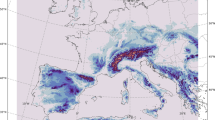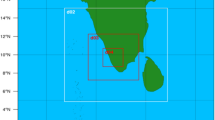Abstract
An extensive work has been done by the Department of Meteorology and Climatology at Aristotle University of Thessaloniki and others using a three-dimensional cloud resolving model to simulate AgI seeding by aircraft of three distinct hailstorm cases occurred over Greece in period 2007-2009. The seeding criterion for silver iodide glaciogenic seeding from air is based on the beneficial competition mechanism. According to thermodynamic analysis and classification proposed by Marwitz (1972a, b, and c) and based on their structural and evolutionary properties we classified them in three groups as singlecell, multicell and supercell hailstorms. The seeding optimization for each selected case is conducted by analysis of the thermodynamic characteristics of the meteorological environment as well as radar reflectivity fields observed by the state of the art Thunderstorm Identification, Tracking, Analysis and Nowcasting (TITAN) software applied in the Greek National Hail Suppression Program (GNHSP). Results of this comprehensive study have shown positive effects with respect to hailfall decrease after successful seeding as our primarily objective. All three cases have illustrated 15-20% decrease in accumulated hailfall at the ground Seeded clouds have exhibited earlier development of precipitation and slight dynamical enhancement of the updraft and rainfall increase of ~10- 12.5%. The results have emphasized a strong interaction between cloud dynamics and microphysics, especially the subgrid scale processes that have impact on agent transport and diffusion in a complex environment. Comparisons between modelled and observed radar reflectivity also show a relatively good agreement. Simulated cloud seeding follows the operational aircraft seeding for hail suppression. The ability of silver-iodide particles to act as ice nuclei has been used to perform airborne cloud seeding, under controlled conditions of temperature and humidity. The seeding effects depend upon applying the seeding methodology in proper seeding time, right placement and agent dose rate.
Similar content being viewed by others
References
Barth, M. C., and Coauthors, 2007: Cloud-scale model intercomparison of chemical constituent transport in deep convection. Atmos. Chem. Phys., 7, 4709–4731.
Bibalashvili, N. S., I. I. Burcev, and J. A. Seregin, 1981: The manual of hail suppression orga-nization and practice (in Russion). Gidrometizdat, Leningrad, 129 pp.
Browning, K. A., 1977: The structure and mechanisms of hailstorms. Hail: A Review of Hail Science and Hail Suppression. Amer. Meteor. Soc, 38, 1–43.
Byers, H. R., and R. R. Braham, Jr., 1949: The Thunderstorm. U. S. Government Printing Office, Washington D. C., 287 pp [out of print].
Cooper, W. A., and J. Marwitz, 1980: Winter storms over the San Juan mountains. Part III: Seeding potential. J. Appl. Meteorol., 19, 942–949.
Cotton, W. R., and R. A. Pielke, 2007: Human Impacts on Weather and Climate. Cambridge University Press, 288 pp.
Dennis, A. S., 1980: Weather Modification by Cloud seeding. Acad. Press, New York, 267 pp.
Dixon, M., and G. Wiener, 1993: TITAN: Thunderstorm Identification, Tracking, Analysis and Nowcasting — A radar-based methodology. J. Atmos. Ocean. Tech., 10, 785–797.
Doswell, C. A. III, 2001: Severe Convective Storms- An Overview. Severe Convective Storms. Meteor. Monogr., 28, 1–26.
Durran, D. R., 1981: The effects of moisture on mountain lee waves. Ph.D. Thesis, Massachusetts Institute of Technology Boston, MA (NTIS PB 82126621).
English, M., 1986: The testing of hail suppression hypotheses by the Alberta Hail Project. 10th Conf. Weather Modification, Arlington, Amer. Meteor. Soc., 72–76.
English, M., and T.W. Krauss, 1986: Results from an Alberta hailstorm seeding experiment. Presented 1st Intl. Cloud Modeling Workshop/Conf., Isree, FRG, July 1985, 79–84.
Foote, G. B., 1984: The study of hail growth utilizing observed storm conditions. J. Climate Appl. Meteor., 23, 84–101.
Georgopoulos, P. G., and J. H. Seinfeld, 1986: Mathematical modeling of turbulent reacting plumes-General theory and model formulation. Atmos. Environ., 20, 1791–1802.
Houze, R. A., M. Biggerstaff, S. Rutledge, and B. Smull, 1989: Interpretation of doppler weather radar displays of midlatitude mesoscale convective systems. Bull. Amer. Meteor. Soc., 70, 608–619.
Hsie, E.-Y., R. D. Farley, and R. D. Orville, 1980: Numerical simulation of ice-phase convective cloud seeding. J. Appl. Meteorol., 19, 950–977.
Isaac, G. A., J. W. Strapp, and R. S. Schemenaur, 1982: Summer Cumulus Cloud Seeding Experiments near Yellowknife and Thunder Bay, Canada. J. Appl. Meteorol. Clim., 21, 1266–1285.
Karacostas, T. S., 1984: The Design of the Greek NHSP. Proc. 9th Conf. on Wea. Mod., A.M.S., Park City, Utah, USA.
Karacostas, T. S., 1989: The Greek National Hail Suppression Program, Design and Conduct of the Experiment. Proc. 5th WMO Sci. Conf. on Wea. Mod. And Appl. Cloud Physics, WMO/TD-269, CHINA, 605–608.
Klemp, J. B., and R. B. Wilhelmson, 1978: The simulation of threedimensional convective storm dynamics. J. Atmos. Sci., 35, 1070–1096.
Klemp, J. B., and D. R. Durran, 1983: An upper boundary condition permitting internal gravity wave radiation in numerical mesoscale models. Mon. Wea. Rev., 11, 430–444.
Kopp, F. J., 1988: A simulation of Alberta cumulus. J. Appl. Meteorol., 27, 626–641.
Krauss, T. W. 1981: Precipitation Processes in the New Growth Zone of Alberta Hailstorms. Ph.D. Thesis, Univ. of Wyoming, Laramie, 296 pp.
Krauss, T. W., 1989: An assessment of seeding rate. Greek National Hail Suppression Program 1988 Annual Report, Edited by Rudolph et al., INTERA Report M88-490, Calgary, 5.2 to 5.4.
Krauss, T. W., and J. D. Marwitz, 1984: Precipitation processes within an Alberta supercell hailstorm. J. Atmos. Sci., 41, 1025–1034.
Lemon, L. R., and C. A. Doswell III, 1979: Severe thunderstorm evolution and mesocyclone structure as related to tornadogenesis. Mon. Wea. Rev., 107, 1184–1197.
Levin Z., and W. R. Cotton, 2008: Aerosol Pollution Impact on Precipitation: A Scientific Review. Springer Press, 386 pp.
Lin, Y. L., R. D. Farley, and H. D. Orville, 1983: Bulk parameterization of the snow field in a cloud model. J. Climate Appl. Meteor., 22, 1065–1092.
List, R., K. R. Gabriel, B. A. Silverman, Z. Levin, and T. Karacostas, 1998: The Rain Enhancement Experiment in Puglia, Italy: Statistical Evaluation. J. Appl. Meteorol., 38, 281–289.
Marwitz, J.D., 1972a: The structure and motion of severe hailstorms. Part I: Supercell storms. J. Appl. Meteorol., 11, No. 1, 166–179.
Marwitz, J.D., 1972b: The structure and motion of severe hailstorms. Part II: Multi-cell storms. J. Appl. Meteorol., 11, No. 1, 180–188.
Marwitz, J.D., 1972c: The structure and motion of severe hailstorms. Part III: Severely sheared storms. J. Appl. Meteorol., 11, No. 1, 189–201.
Mason, B. J., 1980: A review of 3 long-term cloud-seeding experiments. Meteor. Mag., 109, 335–344.
Orville, H. D., and F. J. Kopp, 1977: Numerical simulation of the history of a hailstorm. J. Atmos. Sci., 34, 1596–1618.
Rosenfeld, D., and W. L. Woodley, 1989: Effects of cloud seeding in west Texas. J. Appl. Meteorol., 28, 1050–1080.
Rosenfeld, D., and W. L. Woodley, 1993: Effects of cloud seeding in west Texas: Additional results and new insights. J. Appl. Meteorol., 32, 1848–1866.
Smith, P. L, G. G. Myers, and H. D. Orville, 1975: Radar reflectivity calculations on numerical cloud models using bulk parameterization of precipitation. J. Appl. Meteorol., 14, 1156–1165.
Sekhon, R. S., and R. C. Srivastava, 1970: Snow size spectra and radar reflectivity. J. Atmos. Sci., 27, 299–307.
Silverman, B. A., 1986: Static mode seeding of summer cumuli-a review, in Rainfall Enhancement-A Scientific Challenge. Meteor. Monogr., 21, 7–24.
Silverman, B. A., 2001: A critical assessment of glaciogenic seeding of convective clouds for rain enhancement. Bull. Amer. Meteor. Soc., 82, 903–924.
Spiridonov, V., and M. Curic, 2006: A three-dimensional modeling study of hailstorm seeding. J. Wea. Mod. 38, 31–37.
Telenta, B., and N. Aleksic, 1988: A three-dimensional simulation of the 17 June 1978 HIPLEX case with observed ice multiplication. 2nd International Cloud Modelling Workshop, Toulouse, 8–12 August 1988, WMO/TD No. 268, 277–285.
Weisman, M. L., and J. Klemp, 1984: Characteristics of isolated convective storms. In Mesoscale Meteorology and Forecasting, American Meteor. Society, 331–348.
Author information
Authors and Affiliations
Corresponding author
Rights and permissions
About this article
Cite this article
Spiridonov, V., Karacostas, T., Bampzelis, D. et al. Numerical simulation of airborne cloud seeding over Greece, using a convective cloud model. Asia-Pacific J Atmos Sci 51, 11–27 (2015). https://doi.org/10.1007/s13143-014-0056-z
Received:
Accepted:
Published:
Issue Date:
DOI: https://doi.org/10.1007/s13143-014-0056-z




